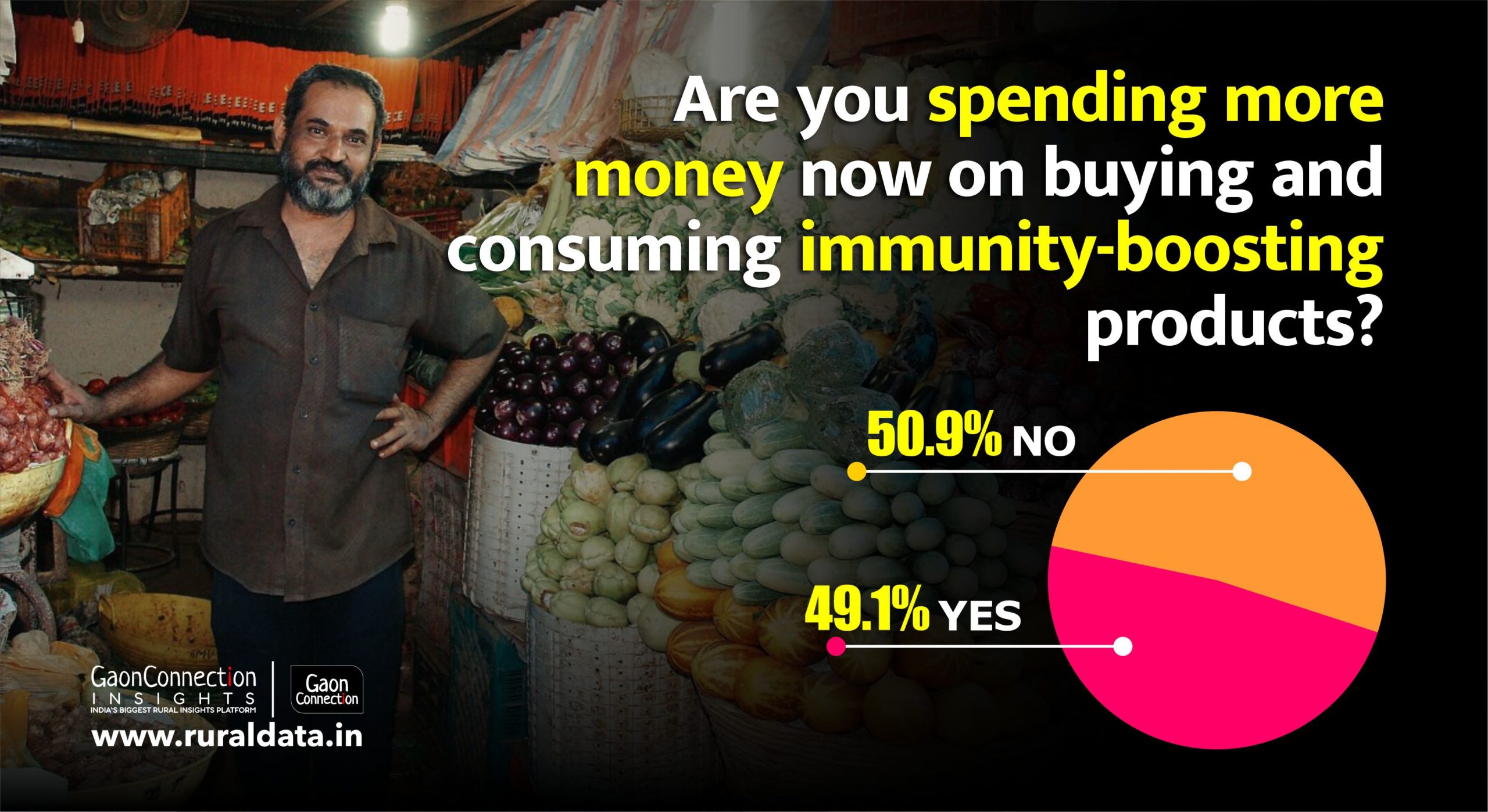Half of rural Indians spending more money in corona period to buy packaged immunity boosting products: Gaon Connection Survey
Chywanprash, Giloy, Kaadha, Tulsi, turmeric milk… rural Indians have increased their consumption of immunity boosting items to protect themselves from the coronavirus. Many have stopped eating out whereas several rural households have reduced their non-veg food consumption.


Rohit Singh, along with his five other family members, lives in Bhikhanapur village of Pratapgarh district in Uttar Pradesh. In the month of September this year, the entire family tested positive for COVID-19. And this pushed them to daily consume kaadha (a concoction of herbs and spices) and spend more money on immunity boosting products.
“Even before we had turned corona positive, we had been drinking kaadha instead of tea and even after recovering from the corona, the whole family continues to consume immunity boosting food such as Chyawanprash, etc,” he told Gaon Connection.
Like Singh, there is a large proportion of rural population in Indian villages which is consuming immunity boosting products and other home remedies to keep the coronavirus at bay. This was reflected in the first survey of its kind by Gaon Connection, India’s biggest rural media platform, conducted across 16 states and one union territory.

The survey found that almost half of rural Indians — 49.1 per cent — were spending more money in buying packaged ‘immunity boosters’ to protect themselves against COVID-19. In high and medium COVID-19 prevalence states, as demarcated in the survey, more than half of respondents were reportedly spending more money on buying and consuming packaged immunity boosting products.
Further, zone-wise analysis showed spending more money now on buying and consuming packaged immunity boosting products was highest in the East zone (63 per cent) and lowest in the north zone (40 per cent) of the country.

Overall, slightly more than half of the respondents (56%) reported that their eating habits had changed in the corona period.
These key findings of the survey on the ‘COVID-19 Vaccine and Rural India’ by Gaon Connection Insights, the data and insights arm of Gaon Connection, have been released as ‘The Rural Report 3: COVID-19 Vaccine and Rural India’ and available in full for a free download on www.ruraldata.in.
The face-to-face survey, conducted between December 1 and December 10, was carried out by Gaon Connection surveyors among 6,040 rural respondents across 60 districts in 16 states and one union territory. The selection of states, covering all regions of the country, was based on the prevalence of COVID-19 as per the COVID data of the Union ministry of health and family welfare, Government of India.
The survey had a margin of error of 5 per cent and a 95 per cent confidence level.
In the Gaon Connection survey, states covered under the north zone include Uttar Pradesh, Bihar, Jharkhand, Himachal Pradesh, Punjab, Jammu and Kashmir, Haryana. States in the south zone include Kerala, Andhra Pradesh, Karnataka. The west zone includes Maharashtra, Gujarat, Madhya Pradesh; whereas the east-northeast zone includes Odisha, Assam, West Bengal, Arunachal Pradesh.

“The immunity boosting products are flying off the shelves,” said Adarsh Jaiswal, who runs a medical store in Delhi. “Since March, the demand for products like Chyawanprash and honey has increased. A lot of companies have also come up with their kaadhas and giloy tablets,” he told Gaon Connection. Whereas previously we used to sell ten Chyawanprash jars in a day, now we are selling more than thirty a day. The demand has further increased due to the winter season,” he added.
In order to enhance the immunity of the body, the Union Ministry of AYUSH (Ayurveda, Yoga & Naturopathy, Unani, Siddha and Homoeopathy ) had also advised intake of Ayurvedic products that included kaadha and Chyawanprash. It also issued an advisory to take 10 grams (one teaspoon) of Chyawanprash in the morning and that the diabetic patients must be given sugar-free Chyawanprash. Drinking of turmeric milk and an infusion of basil, cinnamon and black pepper twice a day had also been advised by it.

“Only those companies that are making Ayurvedic products, are running in profit during corona times. People’s confidence in the doctors and prescriptions of Ayurveda has increased. The Ministry of Ayush is continuously making people aware of the products such as Giloy, Tulsi, Ashwagandha that enhance the immunity of the body,” A K Prajapati, the head of department of Rasa Shastra and Bhaishajya Kalpana at the Delhi-based All India Institute of Ayurveda told Gaon Connection. “In the last few months, people have realized the benefits of such products and spending money on buying them by curtailing other unnecessary expenses. Herbal products are unique in the sense that they don’t have any side effects but are only beneficial to the body,” he added.
During the Gaon Connection survey when the respondents were asked whether their eating habits had undergone any change in the corona period, more than half or 56 per cent said that their eating habits had changed. Of these, 70 per cent said that they had stopped eating outside, while 30 per cent said they had begun consuming more fruits and 33 per cent said they were consuming more green vegetables. However, another 18.8 per cent of the respondents said they were not getting adequate food in the pandemic.

Region wise, 52.3 per cent of respondents in the eastern and north-eastern states said that they had stopped eating outside, 19.3 per cent said that they had started eating more fruits and 30.6 per cent admitted to eating more vegetables. In the eastern and north-eastern zone , almost every third family (29.5%) was unable to access adequate food.
Majority of the respondents (81.1%) in the western zone had reduced their eating out, and a majority in the south zone had started consuming more fruit (41.6%). and vegetables (42.3%).
With the COVID-19 outbreak, rumours had started spreading that the pandemic spread through chicken, egg, and meat and fish. Those respondent households (53.8 per cent) who said they consumed non-vegetarian food items, were asked if there was any change in their non-veg diet.

Almost 40 per cent households reported that their consumption of non-veg food items had reduced with maximum proportion of reduction had occurred in high COVID-19 prevalence states (49.9%) followed by medium (40.9%) and low COVID-19 prevalence states (31.3%).
Meanwhile, almost nine per cent households reported that during COVID 19 period they were not eating non-veg items anymore.

